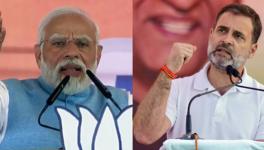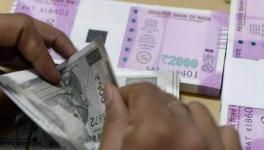Economic Survey 2017-18: India Awaits Another Voice

Newsclick Image by Nitesh Kumar
Arvind Subramanian, author of the Economic Survey 2017-18 placed in Lok Sabha on 29 January, is the Chief Economic Adviser to the government of India. Since finance minister Arun Jaitley is all praise for the Economic Surveys authored by Subramanian, it can be assumed that these documents represent the views of the govt. That’s a really scary thought.
The Economic Survey deals with two of the biggest crises confronting Indians in a nakedly cavalier manner. These are: the agricultural crisis and the jobs crisis. Subramanian quotes the poet T.S.Eliot in the Preface to the Survey: “For last year’s words belong to last year’s language. And next year’s words await another voice.” One can only hope that next year, when elections take place, the country will be free of the incumbent rulers and a different voice will guide the floundering economy.
Last year saw a mighty ferment taking place among the farmers of the country as they desperately fought back the tide of falling farm incomes and indebtedness. There were protests in over a dozen states, there was a massive ‘mahapadav’ at the Parliament in Delhi. So much so that, in various elections, this discontent was reflected in falling support for the ruling party in rural areas.
It would be obligatory for any review of Indian economy to analyse this. After all, agriculture accounts for about 49% of India’s employment. But the Survey tackles this by resorting to an age old trick. Where do you hide a needle? In a haystack. So, the Survey hides the flaming markers of these two crises in tons of verbiage, scattered here and there among its 500 odd pages. To complete the deception, it has an entire chapter not on the current crisis in agriculture but to the forthcoming crisis due to climate change.
The Survey admits in the first chapter that “In the last four years, the level of real agricultural GDP and real agriculture revenues has remained constant, owing in part to weak monsoons in two of those years”. Later, it again admits that in the last few seasons farm revenues have declined for a number of crops despite increasing production and market prices have fallen below the Minimum Support Price (MSP). It confesses that area sown has dipped leading to unemployment.
It also admits that real wages in agriculture have stagnated over the past four years, showing a steep drop in 2016 followed by a recovery to previous levels in 2017.
Yet the Survey has no solutions even in general terms. It continues to talk glibly and callously of how progress means people shifting out of agriculture to non-farm employment not daring to acknowledge that there is no alternative employment in manufacturing or services.
On the employment front, a deceptive smokescreen is erected by the Survey about how ‘formal’ employment is growing far beyond expected and assessed by accepted numbers. To prove this, it takes recourse to using registration in Employees Provident Fund (EPF) and Employees State Insurance (ESI) data and also GST registration figures.
These data sets which are not publicly available were recently analysed by two economists Pulak Ghosh of IIM Bangalore and Saumya Kanti Ghosh of SBI to say that formal sector makes up about 31% of all non-farm employment. In the process, Ghosh and Ghosh have facilely changed the whole meaning of ‘formal’ employment.
The International Labour Organisation defines informal jobs as “Employees are considered to have informal jobs if their employment relationship is, in law or in practice, not subject to national labour legislation, income taxation, social protection or entitlement to certain employment benefits (advance notice of dismissal, severance pay, paid annual or sick leave, etc.).”
It is well known that there can be informal jobs even in big organized industrial units. Indian industry, including the state run enterprises, has made abundant use of out sourcing to contractors as a means of informalising regular jobs. In these cases, the entities the informal workers are linked to may be registered with GST, or the contractors of such workers may even provide health coverage or provident fund benefits. Does that make them ‘formal’ workers? No, because a host of other national labour laws that ensure security of service, minimum wage etc. are still not applicable to them.
In any case, the Survey – and the govt. – is ducking the real issue by waxing eloquent about the so called growth in ‘formal’ jobs. About 120 million persons join the labour force every year in India. But, as successive surveys by the Labour Bureau and other institutions have shown, job growth is less than 1% per year for the past few years. Whether it is formal or informal, is not the question. There are no jobs.
The Economic Survey has simply evaded the most crucial problems wracking the country’s economy and causing immense distress to the people. This is in line with its neoliberal prescription for the future – more private investment, more export. Both have been tried in several countries and failed spectacularly. In India, this govt. as well as the previous ones have tried this and failed. But Subramanian and Jaitley continue to peddle this bankrupt line causing incalculable damage to the country.
Let us hope that next year will indeed bring another voice. India sorely needs it.
Get the latest reports & analysis with people's perspective on Protests, movements & deep analytical videos, discussions of the current affairs in your Telegram app. Subscribe to NewsClick's Telegram channel & get Real-Time updates on stories, as they get published on our website.
























